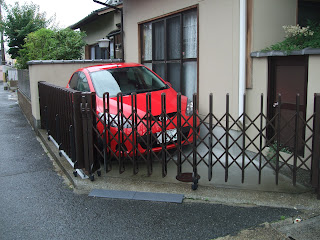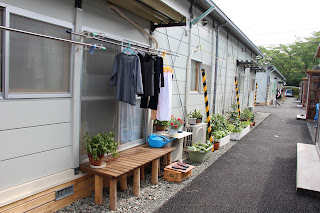 | |
| Fukushima prefecture, close to the no-go area |
* De Nederlandse tekst vind je verderop *
A nuclear power free Japan was short-lived. Prime
minister Noda now approved the start up of two OI plant reactors
located close to Kyoto. It will take a few weeks before they are
fully up and running but the government felt that reactors should be
started up to prevent a potential power crunch this summer. And so he
added, “we need it to ensure a sustainable growth”.
I find the
use of the word ‘sustainable’ in this context remarkable given
that the term has long been used to argue against nuclear energy. As
such, it is a solid part of the vocabulary of the anti-nuclear
movement. Its use here is ironic and indicative of the ‘defeat the
enemy with their own weapons’ communication strategy – a strategy
that, in my opinion, has also been extensively used by Dutch
politicians. In fact, the former vice prime minister Verhagen, who,
by the way, seems to have dropped off the planet since the cabinet
fell last April, often spoke of how ‘clean’ nuclear energy is in
his pleas for more nuclear plants in the Netherlands and made
frequent references to the fact that, with nuclear energy, there are
no CO2 emissions.
With the re-opening of these two nuclear plants, the debate on energy has flared up again. Strikingly, most Japanese people are against nuclear energy. In fact, about three quarters of the Japanese population claim to want a nuclear-free Japan and people have shown great self-discipline in reducing their energy consumption. Energy saving has become a kind of national sport. Even electricity bills include hints for energy reduction. Additionally, investments in renewable energy installations are rapidly increasing. For example, sales of solar cells rose 30.7% in 2011. Initiatives to influence political decision-making, however, have had little success thus far. Last week, the Tokyo council rejected a petition signed by 320,000 residents that lobbied for a referendum on nuclear energy in Tokyo and the urgent energy-related requests made by two governors of regions close to the Oi plant have not honoured. They asked Noda to put the plant into operation for only a limited period of time as not all safety procedures have been tested, but Noda and his allies claim that energy supply is a national issue and should thus be decided upon at national level. The governors, the mayors, and the residents oppose that they should call the shots since they have to carry the heavy costs of a nuclear catastrophe.
So, ultimately, this is not about energy; it is about
power and control, and I think it would be better if the debate were
to be framed in this context. As one may rightfully ask whether a
part of modern society as necessary and vital as energy is should be
owned, and thus controlled, by private, market-driven corporations?
The Fukushima catastrophe has painfully demonstrated that as long as
control over energy remains in the hands of a mere few, we risk not
only damage to the environment but to democracy as well.
 | |||
| Nihonmatsu refugee camp |
Fukushima 2
Een kernenergie-vrij Japan was maar een kort leven beschoren. Half juni heeft premier Noda toestemming gegeven om twee reactoren van de Oi centrale, vlak bij de provincie Kyoto, op te starten. Het argument is dat men een energie tekort in de zomer wil voorkomen. Verder zei de premier: “We hebben kernenergie nodig voor een duurzame groei van de economie”.
Het is merkwaardig dat het woord ‘duurzaam’ juist in dit verband gebruikt wordt. De term is nou net een van de belangrijkste argumenten tegen kernenergie en hoort thuis in het vocabulaire van de anti-kernenergie beweging. Deze communicatie truc – ‘versla je vijand met eigen wapens’ – kennen Nederlandse politici ook. Voormalig vice premier Verhagen (ooit nog iets van hem gehoord sinds de val van het kabinet?) blijft maar hameren op het feit dat kernenergie schone energie is. Wat hij feitelijk bedoelt is dat er geen CO2 uitstoot is.
Maar hoe duurzaam kan de groei van de Japanse economie zijn zolang er nog rekeningen open staan? Zoals de rekening van 19 miljard yen (190 miljoen euro) die de burgemeester van Futabato, een klein stadje in het getroffen gebied, onlangs overhandigde aan TEPCO voor de schade door de Fukushima kerncentrale. Maar de totale kosten van de schade zijn astronomische bedragen. Het gaat dan niet alleen om schoonmaak-kosten, maar ook over de schade die 2 miljoen mensen hebben geleden, over compensatie voor de zeventig tot honderd duizend vluchtelingen die hun huizen, land, vee, boomgaarden enzovoorts achter hebben moeten laten; en over compensatie voor het vervuilde gebied van zo'n 30 kilometer dat totaal onbruikbaar is. En dan zijn er ook nog de immateriële verliezen die natuurlijk helemaal niet te becijferen zijn: de vernietiging van de sociale infrastructuur, die zo belangrijk is voor de lokale economie, het verdwijnen van sociale banden en de zware psychische trauma’s. Tot nu toe zijn er nauwelijks rekeningen betaald. De verliezen worden gedragen door de getroffenen en de overheid.
Nu
de eerste kerncentrale weer actief wordt, laait de discussie over
kernenergie weer op. De meerderheid van de Japanners is tegen.
Driekwart wil een kernenergievrij Japan en de mensen hebben het
afgelopen jaar heel gedisciplineerd hun elektriciteitsgebruik terug
gebracht met zo’n 15 procent. Energie besparen lijkt hier wel een
nationale sport. Zelfs op de elektriciteitsrekening staan tips hoe je
kunt besparen. Tegelijkertijd nemen de investeringen in alternatieve
energie snel toe. De verkoop van zonnecellen bijvoorbeeld is in 2011
met 30 percent gestegen. Initiatieven om de politiek te beïnvloeden
vinden echter geen gehoor. Kort geleden heeft het bestuur van Tokyo
tegen een referendum over kernenergie gestemd, na een petitie
ondertekend door 320.000 inwoners. Zelfs dringende verzoeken van de
gouverneurs van de twee provincies die grenzen aan de Oi centrale
zijn niet gehonoreerd. Zij hadden premier Noda gevraagd de centrale
alleen tijdelijk open te stellen, omdat nog steeds niet alle
veiligheidsprocedures goed afgerond zijn. Noda en andere politici
claimen nu dat energie een nationale aangelegenheid is. De
beslissingsbevoegdheid moet daarom ook op nationaal niveau liggen. De
gouverneurs, burgemeesters en inwoners daarentegen vinden dat zij de
zwaarste stem moeten hebben, omdat zij de rekening betalen als het
fout gaat.
Dus
uiteindelijk gaat het niet om energie, maar om macht en controle. Het
zou ook beter zijn als de discussie in dit kader geplaatst wordt.
Want je kunt je terecht afvragen of zoiets belangrijks - en
gevaarlijks - als kernenergie wel in handen moet blijven van private,
markt gestuurde bedrijven. De catastrofe van Fukushima maakt pijnlijk
duidelijk dat zolang een kleine groep de energievoorziening in handen
heeft, we niet alleen schade voor het milieu riskeren, maar ook voor
de democratie.








